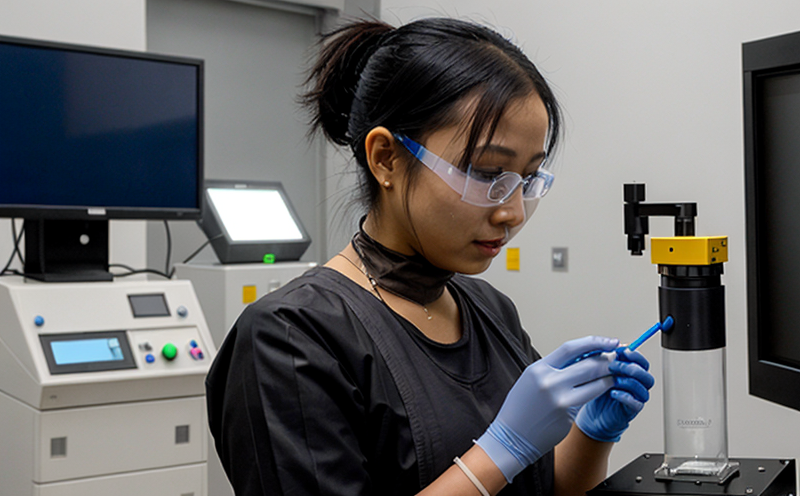ISO 17294 Determination of Trace Elements in Water Samples with Nanoparticles
The ISO 17294 standard is a critical tool for determining trace elements in water samples that contain nanoparticles. This service plays an essential role in environmental monitoring, particularly when assessing the impact of nanomaterials on aquatic ecosystems and human health.
Trace elements are crucial components in various biological processes. When present in water, they can exhibit different behaviors due to their nanoparticle form compared to their bulk counterparts. The presence of trace elements in water samples, especially in the context of nanoparticles, has become a significant area of concern for environmental and public health sectors.
The ISO 17294 standard provides detailed methodologies that ensure accurate detection and quantification of trace elements. This includes a comprehensive process from sample collection to final analysis. The methodology involves several stages: initial water sampling, filtration or dilution as necessary, digestion, and finally, the use of appropriate analytical techniques like inductively coupled plasma mass spectrometry (ICP-MS) for precise measurement.
The importance of this service cannot be overstated, especially given the increasing use of nanomaterials in various industries. Environmental regulations are becoming more stringent to manage the potential risks associated with these materials. This service not only meets regulatory requirements but also supports research and development efforts aimed at minimizing environmental impacts.
Our laboratory employs state-of-the-art equipment and highly skilled technical personnel, ensuring accurate results that comply with international standards. The precision and reliability of our tests are crucial for stakeholders involved in water quality management, compliance monitoring, and product safety assessment.
The impact of this service extends beyond regulatory compliance. It also aids in the development of safer nanomaterials by providing insights into how trace elements behave in nanoparticle form. This knowledge is vital for innovation in industries ranging from pharmaceuticals to electronics, where nanotechnology plays a significant role.
Scope and Methodology
The ISO 17294 standard defines the scope of this service by specifying the types of trace elements that can be analyzed and the conditions under which these analyses are conducted. The methodology outlined in the standard ensures consistent and accurate results, regardless of the laboratory performing the analysis.
Sample preparation is a critical step in the process. It involves filtering water samples to remove larger particulates before digesting them for easier trace element extraction. Digestion can be achieved through various methods, including acid digestion or microwave-assisted digestion. Once digested, the sample undergoes thorough rinsing and transfer into suitable containers.
The analytical techniques employed are highly sensitive and specific. In this context, inductively coupled plasma mass spectrometry (ICP-MS) is often used due to its ability to detect very low concentrations of trace elements with high precision. The use of ICP-MS ensures that even minute quantities of trace elements can be accurately measured.
The standard also includes acceptance criteria for the results, specifying allowable limits and tolerances. These criteria ensure that only samples meeting predefined standards are considered compliant. This is essential for regulatory compliance and to maintain high-quality standards in environmental monitoring.
International Acceptance and Recognition
The ISO 17294 standard has been widely adopted by governments, industries, and research institutions around the world. Its international recognition underscores its importance in ensuring consistent and reliable results across different regions.
Governments rely on this service to enforce environmental regulations that protect water resources from contamination by trace elements present in nanoparticles. Industries use these tests to ensure their products meet safety standards, thereby safeguarding public health and the environment.
Research institutions also benefit from this service as it provides valuable data for developing safer nanomaterials. By accurately determining the presence of trace elements, researchers can better understand their behavior and potential risks.
The widespread acceptance of ISO 17294 is a testament to its relevance in today’s world. It serves as a benchmark for quality and reliability in environmental testing, ensuring that stakeholders have confidence in the results they receive.
Competitive Advantage and Market Impact
The competitive advantage of offering this service lies in our ability to provide accurate, reliable, and compliant results. Our laboratory is equipped with advanced technology and highly skilled personnel, ensuring that we can meet even the most stringent standards.
For quality managers and compliance officers, this service offers peace of mind by confirming that their products or processes adhere to international standards. This not only enhances reputation but also fosters trust among customers and stakeholders.
R&D engineers benefit from our expertise in environmental nanomaterials testing. By understanding the behavior of trace elements in nanoparticle form, they can innovate safer materials and processes. This contributes to sustainable development and reduces environmental impact.
Our service has a significant market impact by driving compliance with regulations that protect water resources. By providing accurate data on trace element levels, we help ensure that industries comply with legal requirements and contribute positively to the environment.





